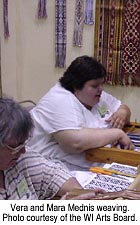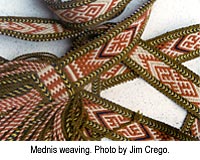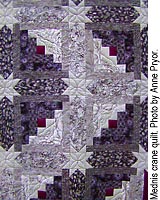Home | Search | The Artists | Teaching | Hiring | About This Site | Contact Us


Traditions In
Their Art

Latvian Weaving
Warrens, WI
 Vera taught her
daughter Mara how to weave. But first, Vera’s mom Emma taught Vera. And before that, Emma’s mom,
Made, taught her.
Vera taught her
daughter Mara how to weave. But first, Vera’s mom Emma taught Vera. And before that, Emma’s mom,
Made, taught her.
When Vera was a girl, her family moved to Wisconsin as political refugees. Her mom, Emma, borrowed a loom and started weaving table cloths. She sold them to support her family. Then Emma taught
Vera to weave and soon they become weaving partners. Vera remembers her mom saying, “You come along with me and work by my side, and we’ll do it together.”![]() Emma wanted to teach Vera a useful skill to financially help their family, and also carry on their Latvian heritage.
Emma wanted to teach Vera a useful skill to financially help their family, and also carry on their Latvian heritage.
Vera remembers growing up with the mission of keeping Latvian culture alive. “We were living in exile, so to speak, in the United States. We were desperately trying to maintain and keep Latvian culture going. So it doesn’t fade, it’s not destroyed. Because during those fifty years of rule, [the Soviets] were doing their utmost, level best to flatten it out. Things were not allowed. In other words, nothing ethnic. So, we keep it up.”
One way Vera kept up the family’s Latvian heritage was by learning how to weave. “I hung there, you know, right behind her,” Vera says. Emma did not let Vera play all afternoon when school was out, like the other children. “...You wove something, you wove a belt that was a replica hundreds of years old. And it just, it had so much more meaning. It gave you pride to help to pull the family along.”
 Vera raised Mara that same way. Today, Vera and
Mara are weaving partners, like Vera and Emma were. Vera and Mara trade orders when people hire them to weave. One time Vera will weave and the next time Mara will weave.
Vera raised Mara that same way. Today, Vera and
Mara are weaving partners, like Vera and Emma were. Vera and Mara trade orders when people hire them to weave. One time Vera will weave and the next time Mara will weave.
When these weavers make traditional pieces, they are faithful to the designs and color schemes passed down to them. But they are artists too and have their own ideas about what looks good. Vera says that her favorite colors are a little darker than her mother’s. And Mara likes brighter colors than Vera. “She is born in America, you see,” says Vera, “she’s brighter, more exuberant. She –‘ah, ooh! I like fuchsia!’ Well, you see, things change. What lives changes. If it doesn’t live, it dies.”
Traditional art forms, like Vera and Mara’s weavings, have an interesting mix of the old tradition and new expressions that an artist creates. Folk traditions are dynamic. That means that they change. Even though a tradition may be old, parts of the tradition change a little every time a new person practices it. Think about a traditional skill you learned from someone else. How have you changed parts of that tradition?
A Dinosaur Learns New Tricks
Vera says she is “a dinosaur” because she “works an old craft,” but this dinosaur still adds to her weaving styles. Since Wisconsin is her home, she has woven designs that
reflect the landscape of our state. The colors and designs
she weaves symbolize the colors and scenes she sees near her home. Let
![]() Vera
tell you about her “meadow” and “thistle” weavings. You can read along by clicking here.
Vera
tell you about her “meadow” and “thistle” weavings. You can read along by clicking here.
Vera and Mara have taken their sense of color and handwork skills in a new direction. In 2001, they entered the Warrens Cranberry Festival Quilt Contest and won Best of Class! Their winning quilt is pictured below. Vera and Mara work as a team when they make quilts, too. Mara pieces the quilt tops, and Vera uses a machine to quilt them together.
 |
Vera and Mara quilted cranes into the quilt with purple thread. Cranes are a common bird in the marshy, cranberry- growing area around Warrens. Many of the Mednis’s weavings are strongly connected to their ethnic heritage, but this quilt is connected to their local community. It highlights the local landscape and the nature that surrounds their area’s most important crop. Click on the photo and see if you can find all six cranes!
Handwork has been an important part of Vera and Mara’s family traditions. Made taught Emma to weave clothing and important traditional items. Emma taught Vera those same weaving techniques. Emma was devoted to honoring and remembering their heritage while living in exile in the United States. Vera learned to card weave and taught Mara both card weaving and loom weaving. Today, Mara and Vera use their hands to create art which is tied to their Latvian roots, their family line and their local community.
In Your Community
Do you have textile traditions in your family? Do you know friends or people in your community who create beauty with thread or fabric? Talk to them! Ask them where they learned their skill. What are the stories behind their pieces of art?
If you’d like to learn how to card weave, check out
Resources for Students. There are picture and text instructions. If you love to learn about the history and culture of different places, surf the web for
sites about Latvia. It has a long and interesting history. Try tracing the immigration of other Latvians to the U.S. Are their stories about about immigration similar to Vera’s or are they different?
![]()

For Educators:
“I then passed it down to my daughter. She’s taking over weaving. And she’s even more a fusion, because I see colors I would have never used..”
– Vera Mednis
![]()
Home | Search | The Artists | Teaching | Hiring | About This Site | Contact Us